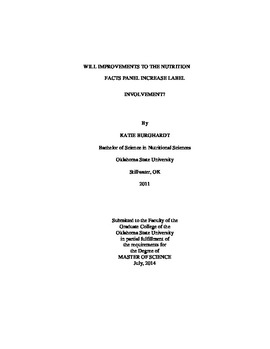| dc.contributor.advisor | Gates, Gail | |
| dc.contributor.author | Burghardt, Katie Beth | |
| dc.date.accessioned | 2015-06-17T20:05:03Z | |
| dc.date.available | 2015-06-17T20:05:03Z | |
| dc.date.issued | 2014-07-01 | |
| dc.identifier.uri | https://hdl.handle.net/11244/14745 | |
| dc.description.abstract | The nutrition fact label has been on foods in the United States since the 1990 Nutrition Labeling and Education Act. While little has changed with the label in the U.S., many countries in Europe have started utilizing front of package labels to inform consumers more quickly, and highlight the nutritional benefits and hazards of food items. Some companies in the U.S. have begun to release their own front of package labeling systems. However, these labels are generally created as a tool for marketing. Therefore, the purpose of our pilot study was to determine what components of food labels most benefit American consumers, what type of label would be most effective in encouraging nutritional choices. Focus groups with a total of nineteen participants were first recruited to obtain preliminary data. The participants were first asked questions to determine how the individuals use nutrition fact labels. The groups were then exposed to a variety of nutrition labels from around the world. They were asked to write down what they thought about the label, and for some, what they liked and didn't like about the labels. Data collected was used to re-focus our study. Results revealed having labels on the front of packages was not as crucial as improving the information on the current nutrition facts panel. Therefore, a survey with a control and two stimuli groups was presented to study participants. 951 individuals participated in the survey. One of the stimulus groups had a caloric breakdown panel accompanying the nutrition facts panel. The other had a panel explaining the percent breakdown of the daily diet. The purpose of these additional panels was to learn if adding them could improve the ability of consumers to use the nutrition facts panel, and learn if they could encourage individuals to make more nutritious choices. We hoped to learn if a summary table supplement to the current nutrition facts label would increase label involvement. We found presenting nutrition label information to individuals who prefer to evaluate potential outcomes, have a greater need for cognition and a higher health consciousness in the form of a percent daily value recommendation chart may be effective. Also, evidence suggested the behavioral makeup, degree of health consciousness and need for cognition of an individual could impact their perception of labels | |
| dc.format | application/pdf | |
| dc.language | en_US | |
| dc.publisher | Oklahoma State University | |
| dc.rights | Copyright is held by the author who has granted the Oklahoma State University Library the non-exclusive right to share this material in its institutional repository. Contact Digital Library Services at lib-dls@okstate.edu or 405-744-9161 for the permission policy on the use, reproduction or distribution of this material. | |
| dc.title | Will Improvements to the Nutrition Facts Panel Increase Label Involvement? | |
| dc.type | text | |
| dc.contributor.committeeMember | Hermann, Janice | |
| dc.contributor.committeeMember | Clare, Greg | |
| osu.filename | Burghardt_okstate_0664M_13345.pdf | |
| osu.accesstype | Open Access | |
| dc.description.department | Nutritional Science | |
| dc.type.genre | Thesis | |
| dc.subject.keywords | evaluation of potential outcomes scale | |
| dc.subject.keywords | food labels | |
| dc.subject.keywords | health consciousness | |
| dc.subject.keywords | need for cognition | |
| dc.subject.keywords | nutrition | |
